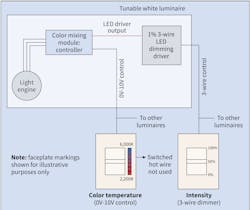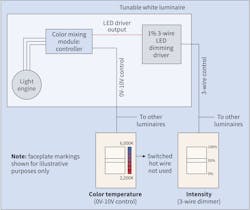Light sources have historically been purchased with a specific color temperature — think “soft white” versus “cool white” fluorescent tube lighting. However, the industry-wide shift to LED lighting offers new capabilities for selecting the exact color of the light and adjust it to meet changing needs in terms of functional lighting as well as aesthetics and wellbeing. Designers and end-users are beginning to embrace and explore this capability, and for installers this means understanding how tunable white lighting systems are configured and controlled. What follows is a look at some of the basics of color tuning and the controls that make it work.
In general terms, tunable white applications use more sophisticated LED drivers and light engines to independently control both the color temperature and the intensity of a luminaire. Tunable white is primarily a technique available in LED luminaires and not for screw-in lamps, although more sophisticated LED screw-in lamps, such as those controlled wirelessly, may offer it as a feature.
There are two primary types of tunable white lighting products: luminaires with separate control inputs for warm intensity and cool intensity, and luminaires with separate control inputs for intensity and color temperature. The difference between the two approaches to tunable white lighting is important, with significant implications for the complexities of configuring the system and for the end-user’s experience using it.
Separate Control Inputs for Warm Intensity and Cool Intensity
The first method for achieving tunable white lighting consists of controlling the intensity of two different color temperature LED loads (e.g., 3,000K and 5,000K). The relative intensity of the two loads determines the resulting color temperature of the system as well as the intensity. The color temperature of the luminaire can be tuned within the bounds set by the individual LED color temperatures. This can be achieved with two dimmable LED drivers, each with a separate control input. The control input can be phase control, 0V to 10V, or digital.
The color temperature and intensity of the luminaire are not completely independent. To achieve a specific color temperature, the LEDs must be set to distinct intensities, which will dictate the overall lumen output of the luminaire. This method reduces flexibility for end-users, due to the following limitations:
• Independent control of intensity and color temperature is not possible.
• This option does not allow for manual raise/lower of intensity or color temperature. Loads can be adjusted strictly via scene-based control to achieve pre-determined “mixes” of the warm and cool LEDs.
• Since intensity raise/lower is not supported, daylighting or load-shed of intensity is also not supported.
• Any timeclock events must be used only to select scenes.
• Intensity and color temperature cannot be guaranteed when fading from one scene to another. Undesired color temperatures or intensities may occur when going from one scene to another, which means timeclock-based scene selection will not provide a good experience.
• Manual overrides cannot revert to a previous level or to a fade. Manual overrides can ONLY revert to a static scene.
• Changing programming (color temperature or intensity of a scene) is an extremely difficult process requiring measurements or table lookups and will be nearly impossible for an end-user to change without support.
• The lighting designer at the job must specify exact percentages for the warm and cool outputs for each scene to achieve desired color temperature and intensity.
Separate Control Inputs for Intensity and Color Temperature
The second type of tunable white luminaire uses one control input for intensity and the other for color temperature. The control inputs for these luminaires are typically 0V to 10V or digital control. Implementation of this method requires a driver that has the capability of dynamically mixing its output (using two or more colors) to generate the requested intensity and color.
The Figure depicts one such implementation: two slide dimmers are used to control a luminaire. One dimmer is used to provide the intensity control signal to an LED driver while the other dimmer provides a 0V to 10V signal to the luminaire’s controller for color temperature control. The color mixing module interprets the 0V to 10V signal and sets the LED light engine to the correct color temperature.
Unlike solutions with warm/cool control inputs, this system is much more flexible. Users can easily set an override of the intensity at any color temperature. For example, a timeclock can be used to vary the CCT throughout the day, while allowing for intensity overrides by occupants.
This method also allows the users the flexibility to have presets for CCT and a raise/lower for intensity. This could be in the form of a four-button keypad (e.g., 6,000K, 5,000K, 4,000K, and 3,000K) with a raise/lower control at the same location for intensity. All common sequences of operation can be supported in the same way as in non-color-tuning situations (daylighting, load shed, etc.).
Some items to consider when specifying this type of tunable white solution:
1. With digital control, all LED drivers communicate on a single low-voltage link as opposed to running independent line-voltage or low-voltage control signals. Digital control schemes can reduce design complexities and wiring material/labor costs as compared to an analog control scheme.
2. Tunable white control with intensity/CCT is necessary when daylight harvesting is also required, since color temperature can remain constant as intensity is adjusted.
3. When designing systems with tunable white control, specifiers should include language requiring control to be provided via separate channels of intensity and CCT. When bidding on projects where the control intent is unclear, manufacturers should include an RFI stating intensity/CCT control is assumed. The RFI should also state that deviations from this method of control will incur significant cost adders, and may not meet the desired sequence of operation. Warm/cool systems are problematic when the system isn’t already designed around very specific LED modules.
4. Sequences of operation should explicitly call out intensity and color temperature values.
Other Variants of Color Tuning
Tunable white lighting systems are just one way lighting manufacturers are making color variations available to customers. Two other popular techniques are “dim-to-warm” and “full color tuning.”
Dim-to-warm is the capability of reducing the color temperature of a light source in proportion to the intensity. This mimics the color shift of incandescent lamps as they are dimmed.
LEDs capable of dim-to-warm require only one control input. The LED driver translates the control input into the appropriate intensity and color temperature. For LED lamps (i.e., screw-based LEDs with integral drivers), the control input is typically forward- or reverse-phase line-voltage control.
Full color tuning is the capability to change the relative mixture of multiple independent base colors (such as red, green, and blue) within a single source of a luminaire.
An early use of LEDs for lighting was theatrical applications where their ability to change color output to any mix of red, green, and blue had great stage value. This ability to change colors was soon adopted to create similar effects in commercial and residential spaces.
This type of color-changing lighting or color modification is different than tunable white and dim-to-warm because it is not based only on maintaining white light. It is meant to produce a color output anywhere within the visible color spectrum. This method is often used in dynamic color-changing applications and involves advanced controllers that interpret digital control signals and regulate the current to individual LEDs.
Full color-changing applications tend to be the most complicated as they typically involve multiple control interfaces and require a well-documented sequence of operations to produce the desired effects for the space. This complexity has been solved by some companies that have developed the entire end-to-end solution.
Conclusion
Tunable white lighting is yet another exciting development on the LED front. Depending on the sequence of operations desired, it is critical to specify luminaires with separate intensity and color temperature inputs to minimize risk to designers, contractors, and owners.
Editor’s note: This article was adapted from an Application Note originally published by Lutron Electronics, Coopersburg, Pa., and is used here with their permission.
Protzman is a director of Building Science & Standards Development for Lutron Electronics in Coopersburg, Pa.

